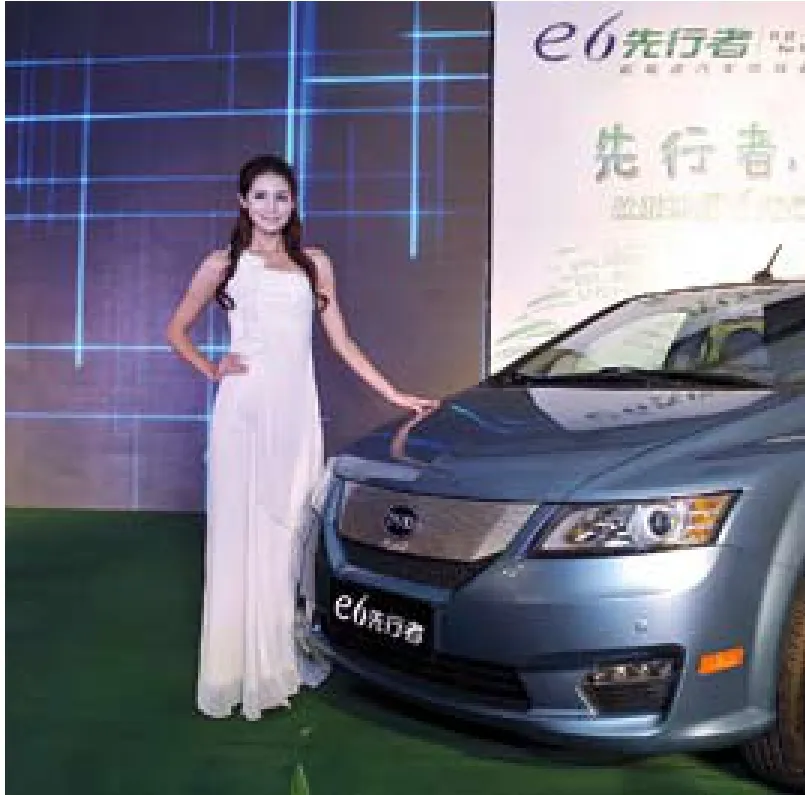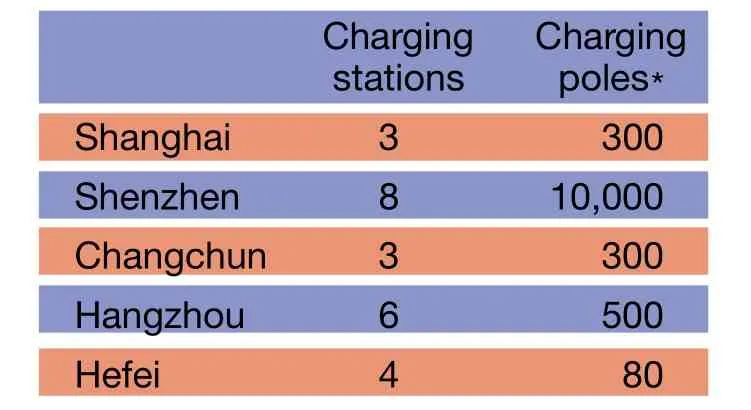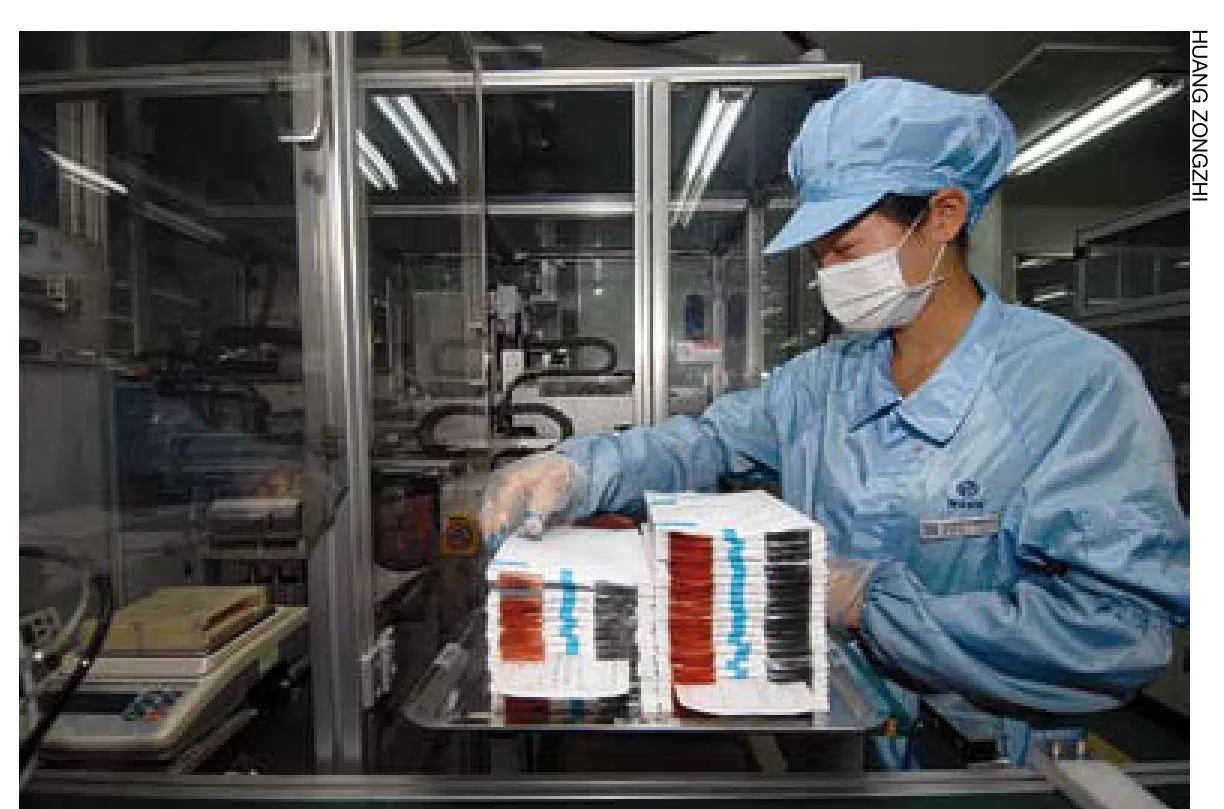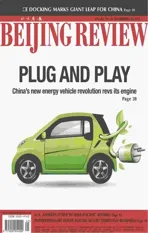GAINING GREEN GROUND
2011-10-14ByLANXINZHEN
By LAN XINZHEN
GAINING GREEN GROUND
By LAN XINZHEN
Promoting the development of new energy autos has become a focal point in China’s green movement
A national technical standard for electric vehicles (EVs) may be set by year’s end, saidNational Business Dailyciting an industry insider from the Society of Automotive Engineers of China on October 12. The issuance of the national technical standard may forcefully promote the commercialization and industrialization of EVs in China.
China already has 46 standards for EVs including hybrid EVs, fuel cell vehicles and pure EVs. According to Wu Zhixin, Deputy Director of China Automotive Technology and Research Center based in Beijing, both government departments and enterprises participated in drafting these standards, referring to international counterparts for frameworks to follow.
One of the major problems with the standards is that China still has not formed a unifed industrial standard on the national level. The new standard will be the frst national standard for EVs, said Wu.
The completion of national technical standardization of EVs will help promote volume production, pave the way for its market expansion and have an enormous influence on accelerating the development of the EV industry, said Li Shengmao, an analyst with CIConsulting, a Shenzhen-based industry research company.
Downsizing to EV
Like other countries, China has also had a fing with new energy cars, giving priority to the development of green cars. The difference is that the future of EVs will outshine non plug-in hybrids. The Ministry of Industry and Information Technologies (MIIT) and other departments consolidated the categories for new energy vehicles: plug-in hybrids, pure electric and fuel cell vehicles. Conventional hybrids and other fuel-efficient gasolinepowered vehicles fall into the category of energy-saving vehicle.
The country has issued various incentives and preferential policies for the R&D and marketing of new energy vehicles.
China is now working on a national plan for developing energy-saving and new energy vehicles. The draft version of the plan focuses on plug-in hybrids and pure EVs.
The draft plan also said that during the 12th Five-Year Plan (2011-15), China will support pure EVs and plug-in hybrid vehicles. It also vows to increase their accumulative production and sales volume. The plan also targeted three core technologies slowing down the development of plug-in hybrids and pure EVs: batteries, electric motors and electric controls.
The country will fully support plug-in hybrid, pure electric and fuel cell vehicles before 2015 and gradually focus its support on pure EVs after 2015, said Ouyang Minggao, Director of the State Key Laboratory of Automotive Safety and Energy Director at Tsinghua University New Energy Vehicle Center.
Setting standards
Enterprises, scholars and institutions are all striving to be a part of this auto trend that assumes the tag of “going green.” But despite their enthusiasm, China still lacks a standard for EVs.
Li said one important problem facing China today in the development of EVs is the lack of nationwide standards for important components.
“In this sense, EV enterprises are not willing to expand their production capacity. As a result, the usage of EVs was limited,” Li said.
A single, national standard will unify the various standards of different EV manufacturers, creating an open and fair space for competition.


China hopes to have more than 500,000 electric cars on the road by 2015 and 5 million by 2020.
The government will help create one to three automakers that can each produce more than 1 million new energy cars per year by 2020. It will also help establish three to five automakers which can each produce more than 500,000 new energy cars per year by 2020.
The target is ambitious, especially since China currently has only approximately 10,000 EVs on the road. To hit the goal, the average growth rate in EV production and sales volume will have to be as high as 118.67 percent until 2015 and then 58.48 percent in the second half of this decade.
Governments at various levels have implemented various measures to support the EV industry by offering generous subsidies for EV purchases and R&D.
In August 2010, the State Assets Supervision and Administration Commission set up the Electric Vehicle Alliance, with participation from 16 centrally administered state-owned enterprises. It is regarded as a national team for upgrading the overall technical level of China’s EV industry. Enterprises in the alliance cover EV makers including FAW, Dongfeng and Changan, battery makers, energy providers such as the State Grid and China Southern Power Grid, and other auto part makers.
The alliance will mainly work to form a complete industrial chain and integrate the efforts in developing China’s EV industry.
The national plan and technical standard to be released will be the major tools to accelerate the large-scale industrialization and commercialization of China’s EV industry. The owners with the winning standards will be the biggest benefciary and take a dominant market share, said Li.
The forerunners
China already has made progress in the EV industry.
Take battery and car maker BYD
Automobile Co. Ltd. for example. BYD has formed a complete industrial chain covering R&D to affliated EV parts, according to Lian Yubo, Vice President of BYD.
On October 26, BYD launched its electric model car, the e6, which can run about 300 km on a single charge, giving it the longest range of any EV in the Chinese market. Before e6, BYD launched a dual-mode hybrid, the BYD F3DM, on the market in 2008.
In addition to BYD, more than 30 domestic EV makers have introduced their own models, some of which include buses that run on electricity. Local governments are usually major buyers of electric buses. As early as 2003, seven cities including Beijing, Tianjin, Wuhan of Hubei Province, Hangzhou of Zhejiang Province and Shenzhen of Guangdong Province launched assessments on the operation of new energy vehicles in their own cities.
During the 2008 Beijing Olympic Games, a fleet of 595 new energy buses traveled a total of 3.7 million km and carried more than 4.4 million passengers, representing the biggest new energy vehicle feet in the history of the Olympics.
Domestic car manufactures, including FAW, Dongfeng, SAIC, Changan, Chery and BYD, all have EV development plans.
The data from the MIIT showed that the industrialization of EV parts has seen a big boost. Battery producers, such as BYD, Tianjin Lishen Battery Joint Stock Co. Ltd., Shenzhen Bak Battery Co. Ltd., and Wangxiang Group have invested heavily in accelerating industrialization of EV batteries.
In addition, more auto parts makers have made efforts to complete the EV industrial chain. It is estimated that China will be able to provide auto parts for 1 million EVs per year in the next two to three years.
In June 2010, the Chinese Government announced a trial program to provide a subsidy of 60,000 yuan ($9,441) for each private purchase of a pure EV and 50,000 yuan ($7,874) for a plug-in hybrid in five cities, including Shanghai, Shenzhen, Hangzhou, Hefei of Anhui Province and Changchun of Jilin Province. One month later, the number of EV pilot cities was expanded from the original 20 to 25. With these efforts, the Chinese Government hoped that EVs could enter more families, rather than only serving as public transport.
Offcial data also showed that as of July 2011 more than 10,000 electric cars have been sold in the 25 cities and more than 1,000 EVs have been purchased for private use.
So far, more than 180 types of new energy vehicles have been approved by the MIIT.
The next decade will be critical for the development of China’s EV industry, said Wang Zhixuan, Deputy Secretary General of China Electricity Council, asserting that China’s traditional auto industry lags behind developed countries but EVs present a golden opportunity for China to catch up with developed countries.
Global cooperation
International cooperation is an important driver for China as it seeks new technology, develops markets and ensures the development of a vehicle market that both meets and sets global standards.
General Motors Co. and China’s SAIC Motor signed an agreement on September 20 to develop new EV R&D platform. For both companies the deal is an opportunity to market these vehicles around the world. The EV platform will be the frst to be codeveloped by a domestic car maker and an international one.
SAIC has gained invaluable experience by operating its own new energy cars during the Shanghai Expo 2010. Next year SAIC will launch a series of plug-in hybrid and pure EVs. The plug-in hybrid model can save 50 percent on oil consumption compared to conventional autos.
BYD has already tapped Europe’s EV market. Last year the BYD F3DM went on sale in Spain and Italy.
In June 2011, BYD signed a letter of intent with Frankfurt, Germany, to introduce BYD’s all-electric eBUS-12. BYD will supply three eBUS-12, two charging stations and technical support until the first quarter of 2012. These electric buses will be used as shuttles at Frankfurt’s airport and public transportation routes.
“This electric bus project shows the tremendous innovation of our city and will expand our leading position in EV development. With BYD, we are implementing a project with a high technological standard that will bring both sides new insights for the design of EV in the future,” said Petra Roth, Mayor of Frankfurt, at the signing ceremony.
In July last year Wan Gang, Minister of Science and Technology, and U.S. Secretary of Energy Steven Chu jointly proposed the U.S.-China Electric Vehicles Initiative. The initiative will include joint standards development, demonstration projects in more than a dozen cities, technical road mapping and public education projects.
The initiative has won positive response from International Energy Agency and other countries, including France, Germany, Japan, Spain and Sweden. So far more than a dozen countries have become members of this initiative. China has also set Shanghai as the international demonstration city for its EV industry, serving as a platform for EV demonstration operation and international exchange.
No easy task
Despite the fact that both central and local governments have set EVs as an integral part of the country’s efforts to build an environ-mentally friendly society, the market has been less than enthusiastic.

(From left to right) REFILLING FUTURE:Staff workers help recharge electric cars at a charging station, the first in Yangzhou, east China’s Jiangsu Province on April 19, 2010


EV Charging Facilities
“China’s EV industry developed quickly and the government also gave it priority, but the market still remains sluggish and it is hard to realize a significant sales surge,”said Cui Shudong, Deputy Secretary General of the China Passenger Motor Vehicles Manufacturers Association.
High prices keep average car buyers away. Li Ru, a Beijing resident, needs to travel more than 20 km to work every day. On a tight budget, he decided against buying an EV.
“If I drive a conventional fuel car, it may cost me more than 300 yuan ($47.24) every month. The EV will save me about 200 yuan ($31.50). But the problem is that EVs are so much more expensive than conventional cars. Even if I fgure in the government subsidies, I still cannot afford it,” Li said.
BYD’s hybrid F3DM car sells for about 140,000 yuan ($22,047), almost 100,000 yuan ($15,748) higher than its F3 model, an identical car with an internal combustion engine instead of the hybrid power source. Chery’s M1 fuel auto costs 50,000 yuan ($7,874), while its EV version M1EV was 140,000-230,000 yuan ($22,047-$35,384).
In an effort to promote the use of electric cars, Beijing has issued a policy that the purchase of battery EVs will not be limited, and owners will not have to go through the license plate lottery. Aside from not having purchase limits, owners of EVs will each enjoy a maximum subsidy of 120,000 yuan ($18,800).
Despite the fact that Beijing gave the green light to EVs, Li was still unwilling to open his wallet to EVs.
“The high price makes consumers lose interest,” said Yan Jinghui, Vice General Manager of Yayuncun Automobile Trade Market in Beijing.
Even if car buyers were willing to pay for EVs, they fnd that there are no pure electric cars for household use available in the market and the market share for plug-in hybrid EVs is less than 10 percent, Yan said.
The dearth of pure EVs will make after-sale services less accessible and cost more, he said.
Charging stations remain a major bump in the road for the EVs to reach their full potential. Since most battery EVs can only run around 150 km on a single charge, a large number of public charging stations are needed. Today, these stations are no more than demonstrations projects.
The Shanghai Municipal Government and the State Grid planned to build 360 charging posts in the city by the end of 2010. Only 50 were fnished.
Shenzhen has been a clear policy leader in EV in China. It is aggressively promoting charging infrastructure: more than 2,000 charging poles have been built in residential communities, but people still say more are needed.
Breakthrough promise
In China, EVs have become an essential part of local governments’ efforts to build an environmentally friendly society. Almost all major cities have EV projects. Shanghai aims to have more than 10,000 EVs by 2012. The EV infrastructure will increase to 13,000 charging poles, 15 charging stations next year.
The Shanghai Municipal Government said it would provide subsidies for investment in EV charging facilities. At the same time, more demonstration centers will be built for residents to learn about and test drive EVs.
In June 2011, Shenzhen announced its top-up subsidies for new energy vehicle purchases as part of a broader national program to encourage fuel-effciency. In addition to the Central Government’s subsidy, Shenzhen decided to provide additional subsidies for the city’s individual buyer of each new energy vehicle. It will also provide subsidies for the construction of supporting facilities for EVs.
Shenzhen also decided to build charging stations in the parking lots of residential communities, big department stores and hotels.
The long-awaited national standard to be released will also provide rules to follow for the construction of the EV recharging station, which will provide investment opportunities for social capital.
The State Grid Corp of China planned to construct 75 charging stations and 6,209 charging poles for EVs across 27 provinces by 2015. State Grid also intended to spend 32 billion yuan ($5.04 billion) to build 10,000 charging stations in the second fve years of this decade.
The traditional energy tycoons, such as Sinopec and PetroChina, also showed interests in EVs. Their thousands of gas stations, when equipped with charging devices, will also serve electric car owners.
EV makers are doing their share by technical innovation. They are trying to make batteries that hold longer charges and charging facilities with the utmost charging capacity within minimum of time.
BYD said they are working on a new type battery that could support 500-km range on a single charge.
“One day if charging stations are as easily found as gas stations and batteries can be charged to their full capacity within 30 minutes, more people will choose EVs,” Li Ru said.

BIG DEBUT: BYD’s all-electric crossover e6 on display in Shenzhen on October 26, 2011

BATTERY WORKSHOP: A worker assembles EV batteries at Wangxiang Group based in Hangzhou, Zhejiang Province
